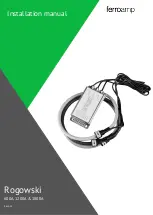
© SF Mobile-Vision Inc. | SEPTEMBER 2020
Part #: 700-1211 R2.0
Appendix H: FCC Compliance
TB-100 Software Installation and Configuration Guide
32
Appendix H: FCC Compliance
This device complies with Part 15 of the FCC Rules. Operation is subject to the following two conditions:
•
This device may not cause harmful interference, and
•
This device must accept any interference received, including interference that may cause undesired operation.
WARNING!
Changes or modifications not expressly approved by the party responsible for compliance could void the user’s
authority to operate the equipment.
This equipment has been tested and found to comply with the limits for a Class B digital device, pursuant to Part 15 of
the FCC Rules. These limits are designed to provide reasonable protection against harmful interference in a residential
installation. This equipment generates uses and can radiate radio frequency energy and, if not installed and used in
accordance with the instructions, may cause harmful interference to radio communications. However, there is no guarantee
that interference will not occur in a particular installation. If this equipment does cause harmful interference to radio or
television reception, which can be determined by turning the equipment off and on, the user is encouraged to try to correct
the interference by one of the following measures:
•
Reorient or relocate the receiving antenna.
•
Increase the separation between the equipment and receiver.
•
Connect the equipment into an outlet on a circuit different from that to which the receiver is connected.
•
Consult the dealer or an experienced radio/TV technician for help.
To comply with FCC/IC RF exposure limits for general population/uncontrolled exposure, the antenna(s) used for this
transmitter must be installed to provide a separation distance of at least 20 cm from all persons and must not be co-located
or operating in conjunction with any other antenna or transmitter.
Canadian Users
This device complies with Industry Canada License-exempt RSS standard(s). Operation is subject to the following two
conditions: 1) this device may not cause interference, and 2) this device must accept any interference, including interference
that may cause undesired operation of the device.
Under Industry Canada regulations, this radio transmitter may only operate using a dipole antenna and a maximum (or
lesser) gain approved for the transmitter by Industry Canada. To reduce potential radio interference to other users, the
antenna type and its gain should be so chosen that the equivalent isotropically radiated power (e.i.r.p.) is not more than that
necessary for successful communication.
This device has been designed to operate with dipole antenna(s), and having a maximum gain of 9 dBi. Dipole antennas
having a gain greater than 9 dBi are strictly prohibited for use with this device. The required antenna impedance is 50 ohms.
This device is granted for use in Mobile only configurations in which the antennas used for this transmitter must be installed
to provide a separation distance of at least 20cm from all person and not be co-located with any other transmitters except in
accordance with FCC and Industry Canada multi-transmitter product procedures.


































